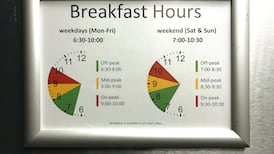Next week it will be two years since the last general election. The date of the next election is, of course, unknown but this is a useful moment to look at the state of the parties as reflected in the polls, not least because the parties’ own perceptions of where they stand may shape when the next election occurs.
There have been 18 polls published by national newspapers since Leo Varadkar became Taoiseach last June. Red C has conducted five polls for the Sunday Business Post. The Sunday Independent has published two polls conducted by Millward Brown. The Sunday Times has published 7 polls conducted by Behaviour & Attitudes. The Irish Times has published three polls by Ipsos Mrbi, one each in January, October and December.
In December the Daily Mail published a poll by new polling agency Ireland Thinks . Some agencies do person-to-person polling, others rely on telephoning polling and some apply different weightings or adjustments to their headline figures.
Averaging out the figure which each of the parties got across those 18 polls since last July is a useful way of evening out the different methodologies. A study of those 18 polls shows an average vote for the four larger parties measured as follows, Fine Gael at 32.5 per cent, Fianna Fáil just under 27 per cent, Sinn Féin at 17.5 per cent and Labour at just under 5 per cent.
It is worth noting that in the general election two years ago those four parties got the following: Fine Gael 25.5 per cent, Fianna Fáil 24.3 per cent, Sinn Féin 13.8 per cent and Labour 6.6 per cent.
Smaller parties
There is little value in looking at the smaller parties across the 18 polls because the variation is so dramatic and the figures so low that averaging them is unreliable. The figure for Solidarity – People Before Profit for example averages 2 per cent, which clearly understates their actual level of support.
On this poll of polls Sinn Féin looks on paper likes its position is improving. However, the party was also up in the high teens in polls in the months before the last general election, but polled just under 14 per cent. This overstatement for Sinn Féin in the polls may endure. It is, of course, too early to assess the impact the change of leader to Mary Lou McDonald will have.
There is no good news for the Labour Party in these polls. They have been as low as 5 per cent for most of that time, and as low as 4 per cent in some polls. There will be no gains for the party whenever the next election comes
There is no good news for the Labour Party in these polls. They have been as low as 5 per cent for most of that time, and as low as 4 per cent in some polls. There will be no gains for the party whenever the next election comes and it will be relying on the strong hold which Brendan Howlin, Seán Sherlock and perhaps Alan Kelly have in their own constituencies to avoid a complete Dáil wipe-out.
On the basis of these 18 polls Fianna Fáil is clearly up on its last general election performance by about 3 or 4 per cent. This has led many in the party to predict gains of perhaps up to a dozen seats when the next election comes.
The most dramatic rise in support, however, has been for Fine Gael, much of it in the last two months. Not only has Fine Gael been above 32 per cent in all polls since December 1st – and reached the dizzy heights of 36 per cent in three of them – but they have also opened an average gap of 8 per cent on Fianna Fáil. That gap matters. It suggests Fine Gael would again have more seats than Fianna Fáil after the next election and, therefore, any re-established confidence and supply agreement would operate to put Fine Gael rather than Fianna Fáil in government.
Biggest jump
The biggest jump in Fine Gael’s support and in Leo Varadkar’s approval ratings happened in December in the aftermath of both the resignation of Frances Fitzgerald and the successful finalisation of the first round of Brexit negotiations. Voters had an opportunity then to look at their new Taoiseach close up in both negative and positive political circumstances.
Varadkar has impressively used the machinery of government. But Fianna Fáil strategists express confidence that they will be able to restrain the Varadkar impact when an election actually comes. They argue that, as in 2016, Micheál Martin and his colleagues will do better in the actual election than the polls suggest.
In reality Varadkar is as likely to surge further in a campaign as he is to slip. Much will depend on the circumstances in which that election is called. It is difficult to see, however, how he or his party could do well enough to remove the need for dependence on another confidence and supply arrangements.
The polls suggest there is currently no rational political reason why either Fianna Fáil or Fine Gael should want an election at this stage.









